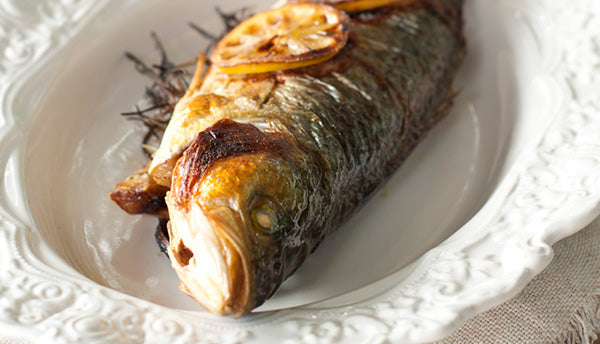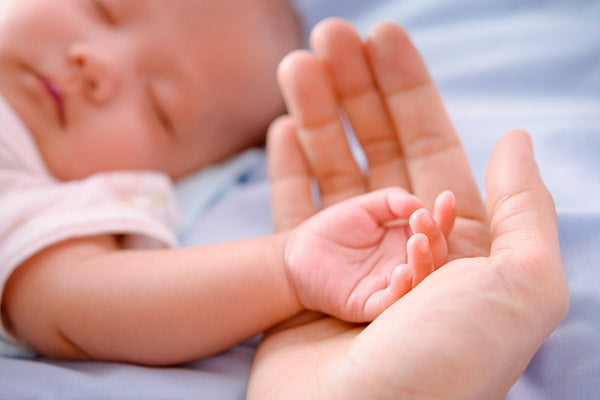Sleep is as vital to your baby's wellbeing as food.
Neuroscientists have found that much of your baby's complex brain development occurs in the weeks immediately before birth and continues at an extraordinary rate throughout the first year of life — much of it while sleeping. At no other point in life does this staggering level of brain development take place.
Some parents assume that their baby instinctively knows how to establish healthy sleep patterns, but in my experience newborns need guidance to learn how to self-settle, resettle and sleep soundly.
As a guide, most newborns will sleep approximately 16 hours in a 24-hour Period, and this will vary from day to day. Some need more sleep than others. How well your baby sleeps will influence your baby's feeding rhythms and have a positive or negative effect on you and your family.
Understanding your baby's sleep cycles will help you deal with challenges in establishing a healthy sleep pattern. Your baby's sleep is composed of light (or Rapid Eye Movement (REM) sleep), and deep (or non-REM) sleep. During the light sleep phase, your baby's brain is exceptionally active, processing the day, storing information and dreaming.
Techniques and tools to help your baby learn how to self-settle and resettle are as follows:
- swaddling
- the ‘engulf hold'
- engulfing in the bassinet/cot
- shushing
- cupping
- patting
- dummies (pacifiers)
- stroking
Swaddling
Swaddling has many benefits but often draws debate — whether you choose to swaddle your baby or not is your choice.
When done correctly, however, in my experience I believe swaddling is comforting and reassuring for newborns and helps establish settling and sleeping.
Use breathable fabrics, such as muslin, light cotton, a cotton/merino blend or merino for both safety and comfort.
When swaddling, be sure to wrap securely around the chest area so that the cloth doesn't ride up over their face. If done correctly, swaddling is not restrictive. It is best to leave the cloth flowing loose from the waist down like a gown.
Correct swaddling does not overheat babies, as long as parents don't overdress their baby, cover their head or overheat the room.
Engulfing
The word ‘engulf' means to surround. With the ‘engulf hold' the emphasis is on drawing your baby close in to your body to provide as much contact as possible.
- The engulf hold is nurturing and reassuring for babies — it provides warmth, security and intimacy and an opportunity to be near your heartbeat and familiar scent.
- It positions a baby at such an angle that their head is higher than their body — ideal for reflux babies when helping them find sleep.
- For breastfeeding mothers, this hold ensures that their baby's face is not too close to the breast where they could easily be tempted towards feeding again.
How to engulf
1. Pick up your baby so they are facing you and draw them in towards your right shoulder so that their head is resting on your upper arm with their face nestling towards your armpit (their body is diagonal to your body).
- Wrap your right arm across your baby's shoulders and take hold of their upper arm or shoulder (the one closest to your face) to firmly support them.
- With your left hand, turn your baby towards you by rolling their bottom upwards and inwards, so that their entire body is pressed firmly into your body — leaving no gaps (it should be impossible to slip a sheet of paper between you). Your baby's face is resting on your upper arm and turned inwards towards your body. Babies who are light-sensitive tend to bury their face into your armpit.
- Place your palm on your baby's bottom to support them. (If right handed then use your other arm to hold the baby in)
Shushing
Shushing is a long, low sound, resembling air being released from a tyre. Ideally, it is loud enough for it to be calming.
Cupping and patting
With all cupping and patting techniques, keep the rhythm firm and steady. It's vital that your body remains still as if it's their bed.
Cupping (small movements on a baby's body)
Cupping mimics your baby's heartbeat, replaces larger movements, and reassures your baby of your presence during self-settling and resettling. It plays a key role in engulfing in the arms and engulfing in the bassinet/cot. It is a gentle but firm movement.
Use it to replace walking, rocking, jiggling, swinging— all of which are movements that cannot be replicated in a bassinet/cot.
There are various ways to cup your baby and it's worth trying them all to see which work best for your baby. The standard way is to hold your baby securely in the engulf hold and rhythmically cup your baby's buttocks.
For babies that don't respond to or don't like this movement, or for babies suffering from reflux or colic, try cupping the area above the nappy line on the baby's lower back. I find babies with reflux and colic often respond well to this variation.
Another way is to combine a cup with a ‘roll', almost as if you are coming from underneath your baby's body to ‘cup and thrust' while adding a rotation as well. This can be done on the side of their bottom, or further up the side at the top of their nappy. Don't be afraid to experiment to find out what your baby likes and what works for you.
The difference between cupping and patting is that when cupping, your hand stays connected to your baby's body throughout whereas when patting, you remove your hand.
Patting
Patting is a firm, repetitive, rhythmic action done with your palm flat on your baby's bottom or thigh area.
Dummies (pacifiers)
Dummies can be useful to help settle your baby. However, in my experience I believe if you ‘plug' your baby as soon as they go to bed, you may take away the opportunity for them to try to settle by themselves. Again in my experience by giving your baby a dummy straight away can cause more crying than if you let them cry/grizzle first before giving it to them.
Stroking
Gently stroking your baby's face is soothing and may help your baby to relax and fall asleep.
Establishing healthy sleep patterns is a long journey and requires TACT — time, acceptance, consistency and touch — as well as repetition, patience and commitment.
Although at times it can be difficult for parents to listen to their baby crying as they attempt to find sleep, it is worth keeping in mind that as long as they are well, not in pain and being nurtured, these small intervals of crying — with you present — are a positive and necessary part of your baby's progress. It will be worth it in the long run!
It is important parents realise what self-settling is not - it is not controlled crying or sleep training. It does not involve leaving your baby to cry it out alone to finally fall asleep depleted, distressed and exhausted.
Self-settling is always done with nurturing. (I want to shout this from the rooftops!) The objective of self-settling is to provide your newborn with a sense they can switch off and fall asleep contented.
When it comes to settling a baby, my advice is to keep it simple. In my experience, the most effective way to help your baby fall asleep is to sit quietly and use small and repetitive techniques, such as cupping and patting that can be done in your arms or in the cot. These subtle but firm movements are calming for a newborn and, when the time is right, can be gently tapered off so that eventually your baby will be able to fall asleep without the need for them.
One of my favourite expressions is, ‘Don't start anything in your arms that you can't replicate in a bassinet/cot.' Be patient and don't forget: babies simply do not have the ability to self-settle (self-soothe) until somewhere between 12 and 16 weeks. Once parents are aware of this, they can enjoy the process and be less fraught with expectation.
Steps to self-settling
The following sequences form the basis of your self-settling routine both day and night whether you do it in your arms or in the bassinet/cot:Swaddle
- Darken the room
- Place your baby in their bassinet/cot while still awake — whether self-settling in arms or cot it is ideal that they begin the cycle in the bassinet/cot
- Don't hover - leave the room quickly and quietly
When your baby cries/grizzles, stop, think and act. In the beginning, it is important that you respond immediately. From here, you have a choice to self-settle your baby in your arms, or in the bassinet/cot, or a mix of both, using the steps below as a guideline.
Self-settling your baby in your arms
Pick up your baby from the bassinet/cot and engulf them
- Choose a quiet place to sit that will provide good support for your back and arms so you can see it through. Your comfort is vital as it is likely that you will be sitting and holding your baby for some time
- Imagine your body is your baby's bed — remain still, no rocking. Stay calm and allow the warmth of your body to nurture your baby, absorbing their cries and tension
- Avoid talking or making eye contact — both are stimulating and provide your baby with a reason to want to stay awake
- Allow your baby to cry/grizzle for one to five minutes … or whatever you feel comfortable with.
- At the end of the interval, reassure with cupping and shushing
- Comfort time should ideally be shorter than crying time. For instance, if you choose to let them cry for two minutes, comfort for one minute
- Stop cupping and shushing
- Allow them to cry/grizzle for one to five minutes (although this interval can be shorter than the first round of crying/grizzling, it should not be longer)
- At the end of the interval, intervene by cupping and shushing (another option is to offer a dummy/pacifier). If they continue to cry, stop cupping and shushing
- Allow them to cry/grizzle for one to five minutes (although this interval can be shorter than the first round of crying/grizzling, it should not be longer)
- At the end of the interval, resume cupping and shushing (another option is to offer a dummy/pacifier)
- If at the end of this cycle they are still not asleep, offer a dummy/pacifier and resume cupping and shushing until they fall asleep
In my experience, it takes around 20 minutes for a baby to find their sleep — that's four lots of five minutes. Ideally, your baby is asleep before this.
Meanwhile, allowing your baby to sleep in your arms is not a cop-out. On the contrary, it instills a sense of security that makes your baby feel nurtured and ready for sleep.
Further Reading:
Read more

Not many people know how to choose sustainable seafood, or where to purchase it from. Sustainable Table has done the homework on species to choose and how to make more sustainable choices. Most of...

It's stinking hot. You are sweaty and so is your baby. He or she keeps grizzling and signalling for more ‘boobie'. Obviously thirsty, you wonder if you should give your little one a drink of water...






